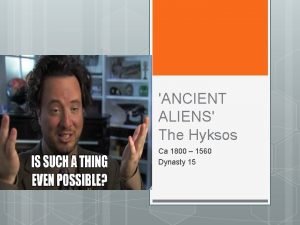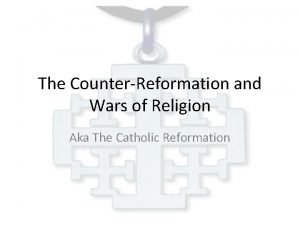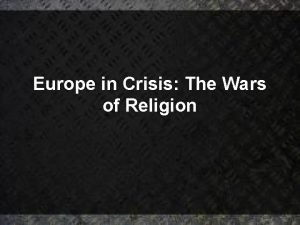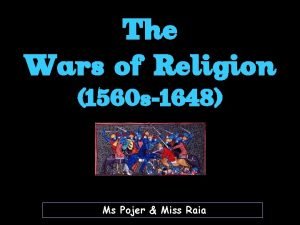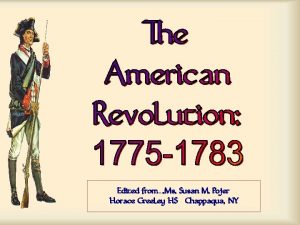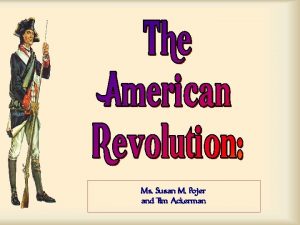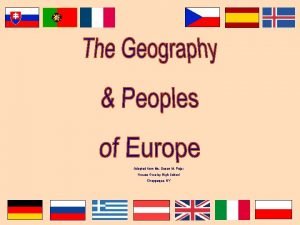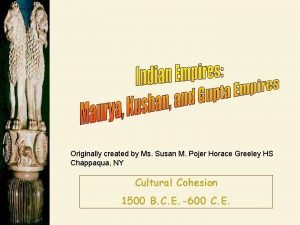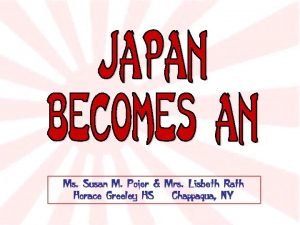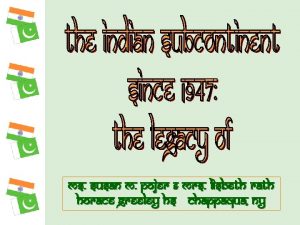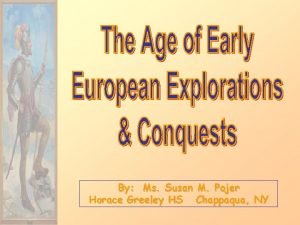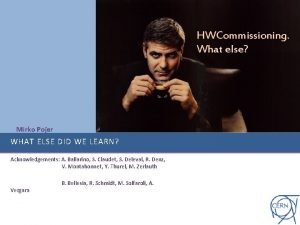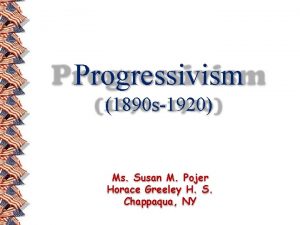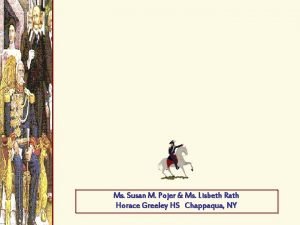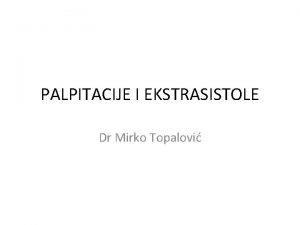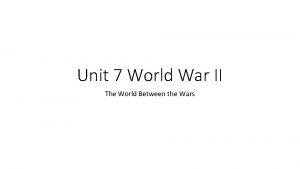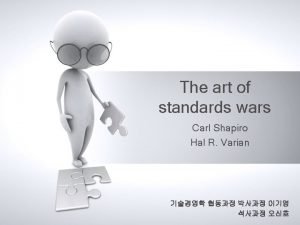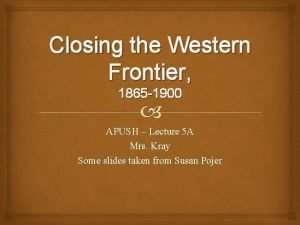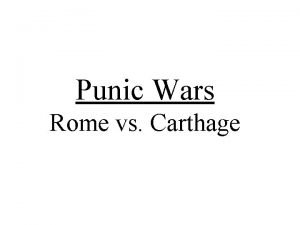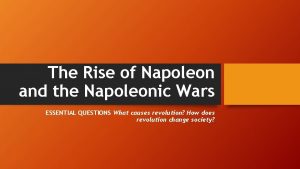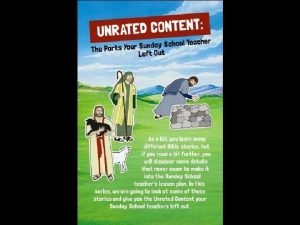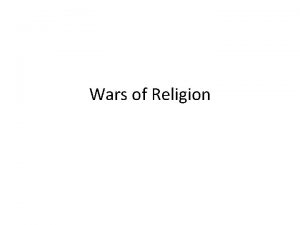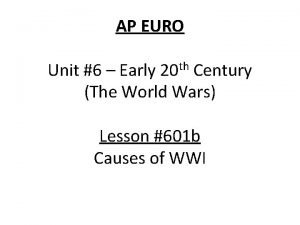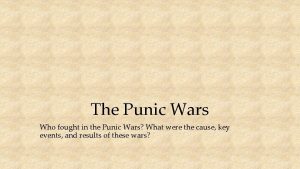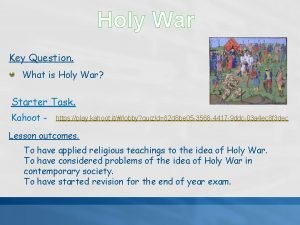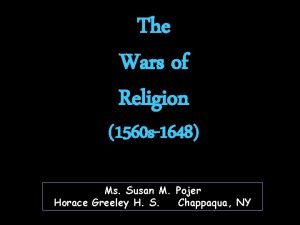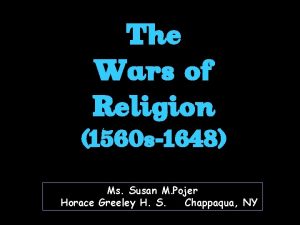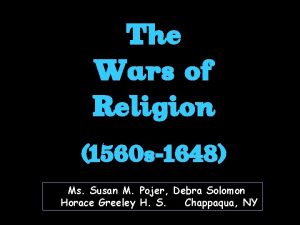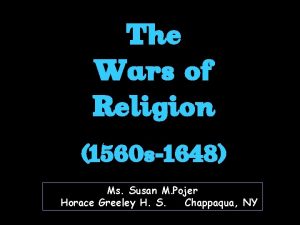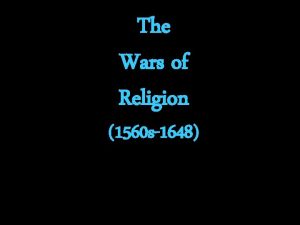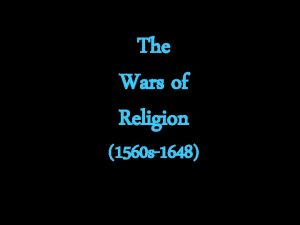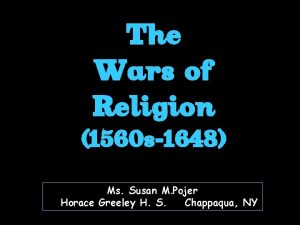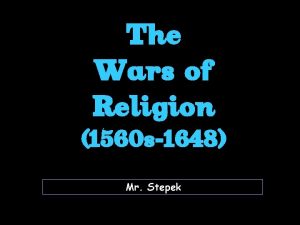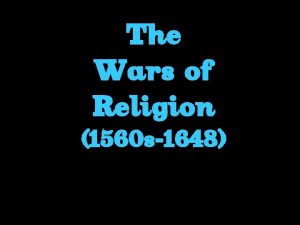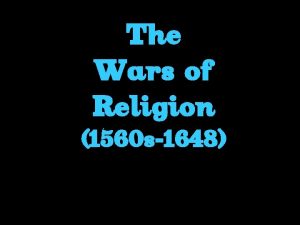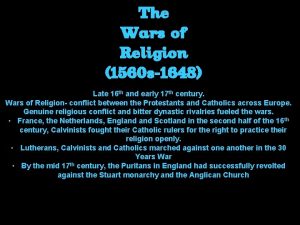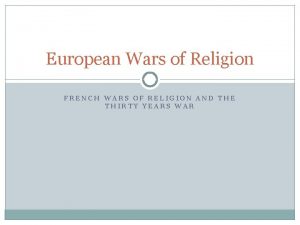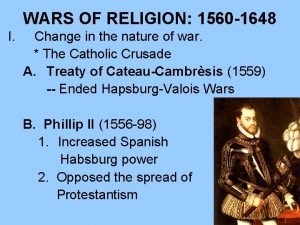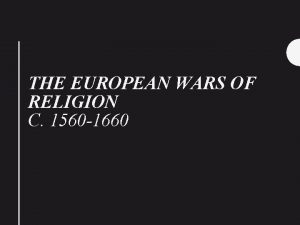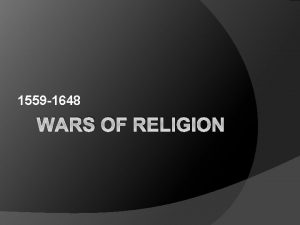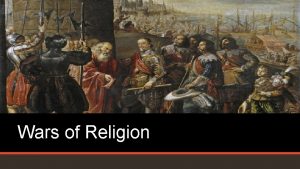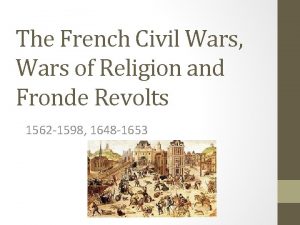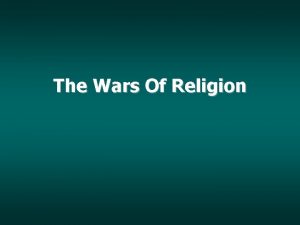The Wars of Religion 1560 s1648 Ms Pojer





![The Town of Escorial [30 km. Northeast of Madrid] The Town of Escorial [30 km. Northeast of Madrid]](https://slidetodoc.com/presentation_image_h/11e875f418cfa3bf8e25e5c25f6c4c83/image-6.jpg)




![Philip II [r. 1556 – 1598] Philip II [r. 1556 – 1598]](https://slidetodoc.com/presentation_image_h/11e875f418cfa3bf8e25e5c25f6c4c83/image-11.jpg)

![The Library Inside the Monastery ( 4, 700 manuscripts [many illuminated]. ( 40, 000 The Library Inside the Monastery ( 4, 700 manuscripts [many illuminated]. ( 40, 000](https://slidetodoc.com/presentation_image_h/11e875f418cfa3bf8e25e5c25f6c4c83/image-13.jpg)



















![James I [r. 1603 -1625] James I’s speech to the House of Commons: I James I [r. 1603 -1625] James I’s speech to the House of Commons: I](https://slidetodoc.com/presentation_image_h/11e875f418cfa3bf8e25e5c25f6c4c83/image-33.jpg)
![James I [r. 1603 -1625] a Wanted absolute power. a He quickly alienated a James I [r. 1603 -1625] a Wanted absolute power. a He quickly alienated a](https://slidetodoc.com/presentation_image_h/11e875f418cfa3bf8e25e5c25f6c4c83/image-34.jpg)
![James I [r. 1603 -1625] a He alienated the Puritans by his strong defense James I [r. 1603 -1625] a He alienated the Puritans by his strong defense](https://slidetodoc.com/presentation_image_h/11e875f418cfa3bf8e25e5c25f6c4c83/image-35.jpg)

![James I [r. 1603 -1625] a Problems he faced: § Large royal debt. § James I [r. 1603 -1625] a Problems he faced: § Large royal debt. §](https://slidetodoc.com/presentation_image_h/11e875f418cfa3bf8e25e5c25f6c4c83/image-37.jpg)

![Charles I [r. 1625 -1649] a Pro-ceremonies and rituals. a Uniformity of church services Charles I [r. 1625 -1649] a Pro-ceremonies and rituals. a Uniformity of church services](https://slidetodoc.com/presentation_image_h/11e875f418cfa3bf8e25e5c25f6c4c83/image-39.jpg)


![Ship Money Assessments, 1636 [per square mile] a A medieval tax for coastal cities Ship Money Assessments, 1636 [per square mile] a A medieval tax for coastal cities](https://slidetodoc.com/presentation_image_h/11e875f418cfa3bf8e25e5c25f6c4c83/image-42.jpg)






![The Battle of Naseby [re-enactment], 1645 a Charles I is defeated at Marston Moor, The Battle of Naseby [re-enactment], 1645 a Charles I is defeated at Marston Moor,](https://slidetodoc.com/presentation_image_h/11e875f418cfa3bf8e25e5c25f6c4c83/image-49.jpg)

![The “Interregnum” Period [1649 -1660] † The Commonwealth (1649 -1653) † The Protectorate (1654 The “Interregnum” Period [1649 -1660] † The Commonwealth (1649 -1653) † The Protectorate (1654](https://slidetodoc.com/presentation_image_h/11e875f418cfa3bf8e25e5c25f6c4c83/image-51.jpg)


![The Puritan Commonwealth [16491653] † Cromwell rules with the Rump Parliament. † Constitutional Republic The Puritan Commonwealth [16491653] † Cromwell rules with the Rump Parliament. † Constitutional Republic](https://slidetodoc.com/presentation_image_h/11e875f418cfa3bf8e25e5c25f6c4c83/image-54.jpg)



![The Protectorate [1653 -1660] † Cromwell tears up the ineffective Constitution. † Dismisses the The Protectorate [1653 -1660] † Cromwell tears up the ineffective Constitution. † Dismisses the](https://slidetodoc.com/presentation_image_h/11e875f418cfa3bf8e25e5c25f6c4c83/image-58.jpg)
![% Of Land Owned by Catholics in Ireland [in green] % Of Land Owned by Catholics in Ireland [in green]](https://slidetodoc.com/presentation_image_h/11e875f418cfa3bf8e25e5c25f6c4c83/image-59.jpg)




















- Slides: 79

The Wars of Religion (1560 s-1648) Ms Pojer & Miss Raia

Hapsburg – Valois Wars • Treaty of Cateau-Cambrèsis, 1559: ends Habsburg Valois Wars (last purely dynastic wars) • France kept Holy Roman Empire from gaining hegemony in Germany, inadvertently helping Lutheranism to spread

Overview • From 1560 to 1648 wars would be fought largely over religious issues – Spain sought to squash Protestantism in Western Europe and the spread of Islam in the Mediterranean – French Catholics sought to re-impose Catholicism in Germany – The Calvinist Netherlands sought to break away from Spanish rule – A civil war occurred in England between Puritans and Anglicans

El Escorial – 26 miles NW of Madrid

The Escorial
![The Town of Escorial 30 km Northeast of Madrid The Town of Escorial [30 km. Northeast of Madrid]](https://slidetodoc.com/presentation_image_h/11e875f418cfa3bf8e25e5c25f6c4c83/image-6.jpg)
The Town of Escorial [30 km. Northeast of Madrid]

El Escorial Statistics ( 15 cloisters ( 16 courts ( 14 entrance halls ( 13 oratory ( 300 cells ( 86 stairways ( 9 towers ( 9 pipe organs ( 232 chorus books ( 73 statues ( More than 1, 600 scenes ( 11 cisterns ( 88 fountains ( 2, 673 windows ( 1, 200 doors

The Monastery of San Lorenzo

The Monastery Gardens: Close-Up

The View of the Countryside from the Monastery Area
![Philip II r 1556 1598 Philip II [r. 1556 – 1598]](https://slidetodoc.com/presentation_image_h/11e875f418cfa3bf8e25e5c25f6c4c83/image-11.jpg)
Philip II [r. 1556 – 1598]

Philip II & “Bloody” Mary Tudor
![The Library Inside the Monastery 4 700 manuscripts many illuminated 40 000 The Library Inside the Monastery ( 4, 700 manuscripts [many illuminated]. ( 40, 000](https://slidetodoc.com/presentation_image_h/11e875f418cfa3bf8e25e5c25f6c4c83/image-13.jpg)
The Library Inside the Monastery ( 4, 700 manuscripts [many illuminated]. ( 40, 000 printed books.

Philip II’s Chapel

Stairwell Inside the Escorial

Philip II Died in this Bed

The Crypt Area

The Crypt of Philip II

The Dutch Revolt • William I (William of Orange) (1533 -1584) led 17 provinces against the Spanish Inquisition – Philip sought to crush the rise of Calvinism in the Netherlands • The United Provinces of the Netherlands formed in 1581 (Dutch Republic) – Received aid from Elizabeth I – HUGE BLOW to Philip – The Dutch closing of the Scheldt River resulted I n the demise of Antwerp as Europe’s Commercial center and the rise of Amsterdam.

Spain vs England • Queen Mary Tudor (Philip’s wife) re-imposes Catholicism in England • Queen Elizabeth I reverses Mary’s edict via the “Elizabethan Settlement”, Act of Uniformity. • Elizabeth helps Protestant Netherlands gain independence from Spain • Spanish Armada, 1588: Philip sought revenge for England’s support for the Dutch as well as hoping to make England Catholic again

The Invasion • Spain's attempt to crush Protestant England • Much of Spain’s navy lay in ruins due to a raging storm in the English Channel as well as the effectiveness of England’s smaller but better built navy. • Signaled the rise of England as a naval power • Adds to the decline of Spain in the end of its Golden Age.

French Wars of Religion: 1562 -1598 I. Seven Wars 1562 -1580 II. Wars of the Three Henrys 1584 -1589 III. War of the League 1589 -1598

Background / Early Years • Wars were Catholics vs. Protestants (Calvinists) = Huguenots • France fell into 40 yrs. of Civil War (1562 -1598). Little unity in France with numerous states, each having their own laws unless King’s laws over rid them. • French NOT attached to the Roman pope for many years – they had their own Pope (Gallican Liberties). • Beginning in 1526, French king nominated Catholic Bishops. • By mid-1500’s, 40% of France nobility was Protestant. • They believed they had the right to control the religion of their own estates. • Catholics were burning Huguenots at the stake beginning in the 1550’s.

Conspiracy of Ambrose (1560) • In 1559, King Henry II was killed accidentally in a tournament. His wife Catherine de. Medici and he had three sons – the oldest only 15 years old, Francis II. – Others were Charles IX and Henry III • In 1560, a plot of Huguenots was usurp power of Guise family, which had great power in France and were Catholic. • Plan: Conspiracy of Amboise was by Louis I de Bourbon to march on Amboise Castle, abduct the French king and arrest leading Guise family members. Guises found out and had rebels massacred and hung from trees around the castle.

St. Bartholomew’s Day Massacre • • Worst attack came Aug. 24, 1572, St. B’s Day when there was a savage Catholic attack on Huguenots. The occasion – Marriage of King Charles IX’s sister Margaret of Valois (Catholic) to Protestant Henry of Navarre Fear: Protestants moving in on throne. Henry of Navarre: . He headed a small independent government – Navarre, and was Protestant (Huguenots) back to Protestantism.

St. Bartholomew’s Day Massacre • • Catherine de. Medici was mom of Francis II (now dead) and new king, Charles IX – young and indecisive. She did not like how Huguenot noblemen, Gaspard Coligny, had so much influence over the throne. The night before the wedding, the leader of the Catholic aristocracy, Henry of Guise had Coligny attacked. Riots and slaughters followed. Catherine de. Medici, a devout Catholic, convinced her son, King Charles IX that Protestants were going to overthrow him. It was a lie. Catherine was also worried that Coligny was conspiring with the Dutch to lead an invasion of Netherlands to drive out Spanish Catholics there. Catherine was not happy about this, she gave the order for the Massacre of Huguenots.

St. Bartholomew’s Day Massacre • Between Aug. 25 and Oct. 3, about 12, 000 Huguenots were killed. Their leader was Henry of Navarre (Bourbon). He escaped and temporarily became Catholic to save himself, then reconverted back to Protestantism.

War of the Three Henrys This massacre led to fighting that launched the Wars of 3 Henrys – civil conflict between: • Henry of Guise (Catholic) • Henry of Navarre (Protestant) • New King, Henry III Valois (Catholic, but leery of Guise’s extremism) • Guises formed alliances of Catholic nobles called “Holy League” and wanted to eradicate Protestantism and replace King Henry III with a Guise. • Catherine de. Medici died and both Henry of Guise and King Henry III died too (since the 2 Henry’s each hired hit men on each other). This enabled the Protestant, Henry of Navarre to become King Henry IV.

Triumphal Entry of Henry IV Into Paris – Peter Paul Reubens

Henry IV of France v Ended Spanish interference in France v Converted to Catholicism : Did this to compromise and make peace § Paris is worth a mass. § This was an example of politique [the interest of the state comes first before any religious considerations] § Fighting for the royal inheritance § v Passed Edict of Nantes in 1598: Granted religious rights to Huguenots § Did not grant religious freedom for all §

The Early Stuarts (1603 -1649)

The Stuart Monarchy
![James I r 1603 1625 James Is speech to the House of Commons I James I [r. 1603 -1625] James I’s speech to the House of Commons: I](https://slidetodoc.com/presentation_image_h/11e875f418cfa3bf8e25e5c25f6c4c83/image-33.jpg)
James I [r. 1603 -1625] James I’s speech to the House of Commons: I am surprised that my ancestors should ever be permitted such an institution to come into existence. I am a stranger, and found it here when I arrived, so that I am obliged to put up with what I cannot get rid of!
![James I r 1603 1625 a Wanted absolute power a He quickly alienated a James I [r. 1603 -1625] a Wanted absolute power. a He quickly alienated a](https://slidetodoc.com/presentation_image_h/11e875f418cfa3bf8e25e5c25f6c4c83/image-34.jpg)
James I [r. 1603 -1625] a Wanted absolute power. a He quickly alienated a Parliament grown accustomed under the Tudors to act on the premise that monarch and Parliament TOGETHER ruled England as a “balance polity. ”
![James I r 1603 1625 a He alienated the Puritans by his strong defense James I [r. 1603 -1625] a He alienated the Puritans by his strong defense](https://slidetodoc.com/presentation_image_h/11e875f418cfa3bf8e25e5c25f6c4c83/image-35.jpg)
James I [r. 1603 -1625] a He alienated the Puritans by his strong defense of the Anglican Church. a Many of England’s gentry [mostly rich landowners below the level of the nobility] became Puritans. § These Puritan gentry formed an important and large part of the House of Commons. § It was NOT WISE to alienate them!

Gunpowder Plot, 1605 Guy Fawkes a An attempt by some provincial Catholics to kill King James I and most of the Protestant aristocracy. a Blow up the House of Lords during the state opening of Parliament.
![James I r 1603 1625 a Problems he faced Large royal debt James I [r. 1603 -1625] a Problems he faced: § Large royal debt. §](https://slidetodoc.com/presentation_image_h/11e875f418cfa3bf8e25e5c25f6c4c83/image-37.jpg)
James I [r. 1603 -1625] a Problems he faced: § Large royal debt. § He wasn’t English he didn’t understand English customs [esp. English law!] § Believed in Divine Right of Kings. § Pro-Catholic sympathies. § Clashed with Parliament v He raised money without Parliament’s consent!

King James Bible, 1611
![Charles I r 1625 1649 a Proceremonies and rituals a Uniformity of church services Charles I [r. 1625 -1649] a Pro-ceremonies and rituals. a Uniformity of church services](https://slidetodoc.com/presentation_image_h/11e875f418cfa3bf8e25e5c25f6c4c83/image-39.jpg)
Charles I [r. 1625 -1649] a Pro-ceremonies and rituals. a Uniformity of church services imposed by a church court. § Anglican Book of Common Prayer for both England AND Scotland. a Seen as too pro-Catholic by the Puritans.

Archbishop William Laud

Charles I & Parliament a Constantly at war with Spain and France. § Always need £, but how to get it? ? a Usually Parliament would give Charles £ from taxes to fund his wars. a Periodically, Parliament would deny funds. § In return, Charles would dissolve Parliament and try to rule England without it find funds in other ways. v Forced “loans, ” selling aristocratic titles, etc.
![Ship Money Assessments 1636 per square mile a A medieval tax for coastal cities Ship Money Assessments, 1636 [per square mile] a A medieval tax for coastal cities](https://slidetodoc.com/presentation_image_h/11e875f418cfa3bf8e25e5c25f6c4c83/image-42.jpg)
Ship Money Assessments, 1636 [per square mile] a A medieval tax for coastal cities for defense. a Charles applied them to inland counties as well. a This got him around the need to call Parliament into session.

The Petition of Rights, 1628 a In return for money to fund his wars, Charles I agreed: § No imprisonment without due cause. § No taxation without Parliament’s consent. § No putting soldiers in private homes. § No martial law during peacetime. a Charles signed it, and then ignored it, dissolving Parliament!

The “Short” Parliament a “Short Parliament” § No Parliament in 20 yrs. § Rebellion in Scotland over Laud issues. § Charles need £ war with France. a Calls Parliament into session in 1640 § MPs demand more protection of property. § Charles dismisses them after 3 weeks. Charles I by Van Dyck (1633)

The “Long” Parliament a In session from 1640 to 1660. § Laud executed. § Triennial Act passed Parliament must be called in session at least once every 3 yrs. § Parliament can’t be adjourned without its own consent! a Charles enters the House of Commons to end the session and arrest 5 MPs unsuccessful a Charles heads north to form an army!

The Civil War (1642 -1649)

Civil War (1642 -1649) Royalists Parliamentarians (Cavaliers) (Roundheads) a House of Lords † House of Commons a N & W England † S & E England a Aristocracy † Puritans a Large landowners † Merchants a Church officials † Townspeople a More rural † More urban

The English Civil War: 1642 -1645
![The Battle of Naseby reenactment 1645 a Charles I is defeated at Marston Moor The Battle of Naseby [re-enactment], 1645 a Charles I is defeated at Marston Moor,](https://slidetodoc.com/presentation_image_h/11e875f418cfa3bf8e25e5c25f6c4c83/image-49.jpg)
The Battle of Naseby [re-enactment], 1645 a Charles I is defeated at Marston Moor, Naseby, and Preston. a He is handed over to Parliament.

The Interregnum (1649 -1660)
![The Interregnum Period 1649 1660 The Commonwealth 1649 1653 The Protectorate 1654 The “Interregnum” Period [1649 -1660] † The Commonwealth (1649 -1653) † The Protectorate (1654](https://slidetodoc.com/presentation_image_h/11e875f418cfa3bf8e25e5c25f6c4c83/image-51.jpg)
The “Interregnum” Period [1649 -1660] † The Commonwealth (1649 -1653) † The Protectorate (1654 -1660)

Pride’s Purge, 1648 † Cromwell purges the House of Commons of moderates [anyone who isn’t anti-monarchy]. † The results is the “Rump” Parliament.

Regicide Beheading of Charles I, 1649 † The vote by the Rump Parliament was 68 -67.
![The Puritan Commonwealth 16491653 Cromwell rules with the Rump Parliament Constitutional Republic The Puritan Commonwealth [16491653] † Cromwell rules with the Rump Parliament. † Constitutional Republic](https://slidetodoc.com/presentation_image_h/11e875f418cfa3bf8e25e5c25f6c4c83/image-54.jpg)
The Puritan Commonwealth [16491653] † Cromwell rules with the Rump Parliament. † Constitutional Republic § Created a constitution Instrument of Government § An executive [Cromwell] § A Council of State annually elected the committee of Parliament. § No monarch. † Europe is appalled other nations don’t recognize it.

Rebels within a Rebellion: Levellers † John Lilburne was their leader. † One of the first libertarians in the world. † The Agreement of the People was their political manifesto. § Abolish corruption within the Parliament & judicial process. § Toleration of religious differences. § Laws written in the vernacular. § Universal suffrage as a “natural right. ”

Rebels within a Rebellion: Diggers † Agrarian “communists” led by Gerrard Winstanley and William Everard seen as the “true Levellers. ” † With Charles I gone, they felt that land should now be distributed to the poor. † Food prices had reached record highs in the 1640 s. † They alarmed the Commonwealth government and angered the local landowners who wanted to claim confiscated aristocratic lands for themselves.

Cromwell Dissolves the “Rump” Parliament in 1653
![The Protectorate 1653 1660 Cromwell tears up the ineffective Constitution Dismisses the The Protectorate [1653 -1660] † Cromwell tears up the ineffective Constitution. † Dismisses the](https://slidetodoc.com/presentation_image_h/11e875f418cfa3bf8e25e5c25f6c4c83/image-58.jpg)
The Protectorate [1653 -1660] † Cromwell tears up the ineffective Constitution. † Dismisses the Rump Parliament and rules with the support of the military. § Declares martial law. § Military dictator. † Religious tolerance for all [esp. for Jews], except for Catholics. † Crushes a rebellion in Scotland. † Crushes a rebellion among the Catholics of Ireland kills 40% of all ethnic Irish!
![Of Land Owned by Catholics in Ireland in green % Of Land Owned by Catholics in Ireland [in green]](https://slidetodoc.com/presentation_image_h/11e875f418cfa3bf8e25e5c25f6c4c83/image-59.jpg)
% Of Land Owned by Catholics in Ireland [in green]

Cromwell—Lord Protector or King? ? † England longs for an end to martial law! † Cromwell dies in 1658 and his son, Richard, takes over, but is weak and lasts for only two years.

The Restoration (1660 -1688) Parliament could no more exist without the Crown than the Crown without Parliament. This was the most important lesson of the English Civil War!

The Thirty Years War (1618 -1648)

1618 -1648

Characteristics of the Thirty Years War Side A: (Mostly Protestant) England (Aid only), Netherlands, Denmark, Sweden, Bohemia, Palatinate (H. R. E. state), Germany H. R. E. Prot. ’s, Saxony and France (Catholic, but opposed Spain, Transylvania • Side B: (Mostly Catholic) Holy Roman Emperor (H. R. E. Catholic forces) and Spain and Poland, Bohemian Leader (Catholic, but nobles Protestant) 4 Phases: 1. Bohemian 1618 – 1625 2. Danish 1625 – 1629 3. Swedish 1630 – 1635 4. Swedish-French 1635 – 1648 • Note: Peace of Augsburg (1555): Holy Roman Empire had 2 choices: Catholicism or Lutheranism.

Background • • • In 1559, Fred III became Elector of the Palatinate (N. of Bavaria): A H. R. E. state. • He converted to Calvinism. • Problem: Peace of Augsburg only allowed Catholicism and Lutheranism. • They then allied with England, Netherlands, and France against Spain in 1609. Bavaria was very Catholic. When next Palatinate Elector, Fred IV formed a defensive league with England, Netherlands, and France in 1609, Maximilian, Duke of Bavaria, formed a Catholic League. By 1618 – War between the two.

Bohemian Phase (1618 -1625) • • In 1618, the Bohemians (Czechs) felt they might lose their Protestant liberties. This was because the future Holy Roman Emperor, Ferdinand II (who was also king of Bohemia) was attempting to make them Catholic. • Ferdinand won after a 5 -year struggle. • Protestants were mainly the nobles; they threw two of Ferdinand’s regents out of a window in the “Defenestration of Prague” – Significance? • The Protestant union dissolved, so king of Denmark (also Duke of Holstein) took lead in Protestant affairs.

Danish Phase (1625 – 1629) • • Denmark’s King Christian IV entered the war with aid from the Dutch and English and promises from France. Meanwhile, Ferdinand II of Holy Roman Empire raised another army led by Albert of Wallenstein. • Catholics faired well. Danish King failed in bringing more Protestantism to the Holy Roman Empire. • He was forced to retreat by Maximilian. The Holy Roman removed Wallenstein, suspicious of his growing power and ambitions. • The Emperor issued the Edict of Restitution (1629): All lands taken from Catholics

Swedish Phase • • • Swedes (Protestants) received money from France and the Netherlands and got involved in the war. The King of Sweden was Gustafus Adolphus. • Troops landed in Holy Roman Empire in 1630. • Sweden and Saxony won a number of victories for the Protestants. • Adolphus was killed in the battlefield. • His chancellor, Oxenstierna carried on. Note: Wallenstein was put back into leading the Holy Roman Empire’s army since the Swedes were doing so well. However, he ceased to fight Swedes and Saxons and entered into talks with them since he hated the Spanish who favored the Holy Roman Empire.

Peace of Prague (1635) • • Treaty between Hapsburg Emperor Ferdinand II and the Elector of Saxony. Brought an end to the civil war aspect of the Thirty Year’s War. Military actions till continued due to intercention by Spain, Seweden and France until the Peace of Westpahlia However, neither France nor Spain fighting and aiding states would stop.

Peace of Prague (1635) • • Treaty between Hapsburg Emperor Ferdinand II and the Elector of Saxony. Brought an end to the civil war aspect of the Thirty Year’s War. Military actions till continued due to intercention by Spain, Seweden and France until the Peace of Westpahlia However, neither France nor Spain fighting and aiding states would stop.

The French Phase: 1635 -1648 v France & Sweden switched roles. v All countries in Europe now participated. v This phase was most destructive! German towns decimated. Agriculture collapsed �famine resulted. 8 million dead � 1/3 of the population [from 21 million in 1618 to 13. 5 million in 1648] § Caused massive inflation. § Trade was crippled throughout Europe. § § §

Loss of German Lives in 30 Years’ War

The French Phase: 1635 -1648 Now more political than religious. By 1635, French were aiding Swedes. So, Spain attacked France itself, seizing Paris. Portugal attacked Spain with the help of France. v German states now united in wanting all foreign powers out. v Thus Protestant intentions won out. v v

The Peace of Westphalia v Political Provisions: § § § § (1648) Each Ger. prince became free from any kind of control by the HR Emperor. The United Provinces [Dutch Neths. ] became officially independent �so. part remained a Sp. possession. Fr. rcvd. most of the Ger-speaking province of Alsace. Sweden �got lands in No. Ger. on the Baltic & Black Sea coasts. Switzerland became totally independent of the HR Emperor �Swiss Confederation. Sweden won a voice in the Diet of the HR Emp. Brandenburg got important terrs. on No. Sea & in central Germany.

The Peace of Westphalia v Religious Provisions: (1648) Calvinists would have the same privileges as the Lutherans had in the Peace of Augsburg. § The ruler of each state could determine its official religion, BUT [except in the hereditary lands of the Habsburgs], he must permit freedom of private worship. §

Treaty of Westphalia (1648)

1688 -1700

Nobody Was Happy! v Many Protestants felt betrayed. v The pope denounced it. v Only merit �it ended the fighting in a war that became intolerable! v For the next few centuries, this war was blamed for everything that went wrong in Central Europe.

What were the long-range effects of the Thirty Years’ War?
 1800-1560
1800-1560 What was the counter-reformation?
What was the counter-reformation? Europe in crisis the wars of religion
Europe in crisis the wars of religion French wars of religion summary
French wars of religion summary Secneer
Secneer Susan pojer
Susan pojer Mirko pojer
Mirko pojer Susan pojer
Susan pojer Susan pojer
Susan pojer Susan pojer
Susan pojer Susan pojer
Susan pojer Susan pojer
Susan pojer Mirko pojer
Mirko pojer Susan pojer
Susan pojer Susan pojer
Susan pojer Mirko pojer
Mirko pojer Mirko pojer
Mirko pojer Susan pojer
Susan pojer Susan pojer
Susan pojer Susan pojer
Susan pojer Mirko topalovic 7
Mirko topalovic 7 Bổ thể
Bổ thể Tư thế ngồi viết
Tư thế ngồi viết Giọng cùng tên là
Giọng cùng tên là Thẻ vin
Thẻ vin Thơ thất ngôn tứ tuyệt đường luật
Thơ thất ngôn tứ tuyệt đường luật Hát lên người ơi alleluia
Hát lên người ơi alleluia Các châu lục và đại dương trên thế giới
Các châu lục và đại dương trên thế giới Khi nào hổ mẹ dạy hổ con săn mồi
Khi nào hổ mẹ dạy hổ con săn mồi Từ ngữ thể hiện lòng nhân hậu
Từ ngữ thể hiện lòng nhân hậu Diễn thế sinh thái là
Diễn thế sinh thái là Vẽ hình chiếu vuông góc của vật thể sau
Vẽ hình chiếu vuông góc của vật thể sau 101012 bằng
101012 bằng Tỉ lệ cơ thể trẻ em
Tỉ lệ cơ thể trẻ em Lời thề hippocrates
Lời thề hippocrates đại từ thay thế
đại từ thay thế Quá trình desamine hóa có thể tạo ra
Quá trình desamine hóa có thể tạo ra Các môn thể thao bắt đầu bằng từ đua
Các môn thể thao bắt đầu bằng từ đua Công thức tính độ biến thiên đông lượng
Công thức tính độ biến thiên đông lượng Thế nào là mạng điện lắp đặt kiểu nổi
Thế nào là mạng điện lắp đặt kiểu nổi Hát kết hợp bộ gõ cơ thể
Hát kết hợp bộ gõ cơ thể Sự nuôi và dạy con của hươu
Sự nuôi và dạy con của hươu Dot
Dot Biện pháp chống mỏi cơ
Biện pháp chống mỏi cơ Vẽ hình chiếu đứng bằng cạnh của vật thể
Vẽ hình chiếu đứng bằng cạnh của vật thể độ dài liên kết
độ dài liên kết Chó sói
Chó sói Thiếu nhi thế giới liên hoan
Thiếu nhi thế giới liên hoan điện thế nghỉ
điện thế nghỉ Một số thể thơ truyền thống
Một số thể thơ truyền thống Thế nào là hệ số cao nhất
Thế nào là hệ số cao nhất Trời xanh đây là của chúng ta thể thơ
Trời xanh đây là của chúng ta thể thơ Lp html
Lp html Số nguyên là gì
Số nguyên là gì đặc điểm cơ thể của người tối cổ
đặc điểm cơ thể của người tối cổ Fecboak
Fecboak Các châu lục và đại dương trên thế giới
Các châu lục và đại dương trên thế giới Tư thế worm breton
Tư thế worm breton ưu thế lai là gì
ưu thế lai là gì Sơ đồ cơ thể người
Sơ đồ cơ thể người Tư thế ngồi viết
Tư thế ngồi viết Cái miệng nó xinh thế chỉ nói điều hay thôi
Cái miệng nó xinh thế chỉ nói điều hay thôi Mật thư tọa độ 5x5
Mật thư tọa độ 5x5 Unit 7 the world between the wars
Unit 7 the world between the wars The art of standards wars
The art of standards wars Closing of the frontier apush
Closing of the frontier apush Corporate wars wall of influence
Corporate wars wall of influence Define persian wars
Define persian wars Carthage harbor today
Carthage harbor today The rise of napoleon and the napoleonic wars
The rise of napoleon and the napoleonic wars Star wars fat slug
Star wars fat slug Effects of the punic wars
Effects of the punic wars A group of 82 students were surveyed
A group of 82 students were surveyed Habsburg-valois wars
Habsburg-valois wars Balkan wars ap euro
Balkan wars ap euro Guild wars 2 elementalist
Guild wars 2 elementalist Who fought in the punic wars?
Who fought in the punic wars? Legenda o syrence
Legenda o syrence Holy wars key
Holy wars key What is a flamewar
What is a flamewar
